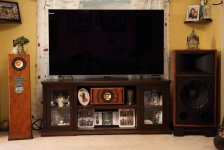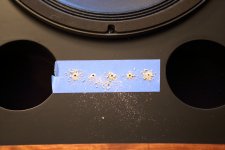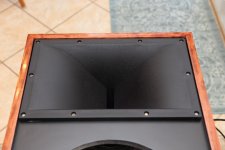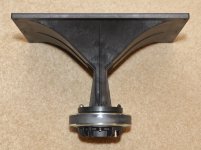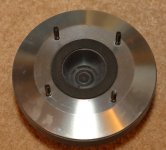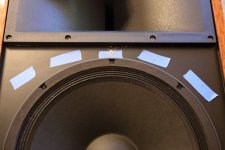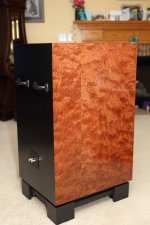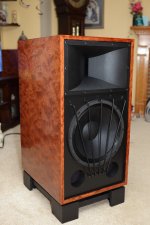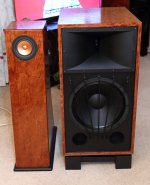Pass DIY Addict
Joined 2000
Paid Member
That one comes pretty close at 5kg per sq meter. The StandartPlast is 6kg/ sq meter. The ones I found elsewhere were much lighter…
Pass DIY Addict
Joined 2000
Paid Member
WOW 😱
Only have a single speaker in place right now and just wow! I’ve been listening to a pair of FHXL speakers for about four years now and I’ve always liked them. The FHXLs are significantly better than the $1000/pr commercial speakers they replaced.
The Calpamos (at least one of them) is an entirely different experience! Clarity and detail are significantly enhanced. Mids and treble are much more clear, though it does not unbalanced or harsh at all. It definitely projects sound into the room more. Bass is much more present (no real surprise there with a gargantuan driver and cabinet). From the front, the Calpamos is about 5-6cm taller the FHXL, but twice as wide. It is certainly an imposing speaker.
Even though I matched the level of the calpamos to the FHXL with my SPL meter, the Calpamos still seems a bit “louder” with general tv and music programming.
Now I just need to get the drivers installed in the second cabinet and move it into the family room to give them a real listen. I’ll post some more images when I get the second one together…
Only have a single speaker in place right now and just wow! I’ve been listening to a pair of FHXL speakers for about four years now and I’ve always liked them. The FHXLs are significantly better than the $1000/pr commercial speakers they replaced.
The Calpamos (at least one of them) is an entirely different experience! Clarity and detail are significantly enhanced. Mids and treble are much more clear, though it does not unbalanced or harsh at all. It definitely projects sound into the room more. Bass is much more present (no real surprise there with a gargantuan driver and cabinet). From the front, the Calpamos is about 5-6cm taller the FHXL, but twice as wide. It is certainly an imposing speaker.
Even though I matched the level of the calpamos to the FHXL with my SPL meter, the Calpamos still seems a bit “louder” with general tv and music programming.
Now I just need to get the drivers installed in the second cabinet and move it into the family room to give them a real listen. I’ll post some more images when I get the second one together…
Eric,
Good to know you got one speaker up and running. You are close to the homestretch - good luck with getting the other completed quickly, and then you can tell us more.
Also look forward to the pics. 🙂
Good to know you got one speaker up and running. You are close to the homestretch - good luck with getting the other completed quickly, and then you can tell us more.
Also look forward to the pics. 🙂
Pass DIY Addict
Joined 2000
Paid Member
Here is one shot of the size comparison between my FHXL speaker on the left and the Calpamos on the right. It takes up more room, but doesn't eat up any more living space than the FHXL does. While the FHXL has a 24" deep footprint (same as the Calpamos) it also tapers toward the top, so it looks much smaller from the side. Probably not 100% ideal placement for either speaker, but the new one fits where I intended it to fit without having to rearrange the furniture.
Attachments
Looks great, that veneer is beautiful !
I see that you found protection grills for the woofer 🙂
Looking forward to hear your second WOW 🙂
I see that you found protection grills for the woofer 🙂
Looking forward to hear your second WOW 🙂
Eric,
Did you have any issues with the veneer rolling up or bubbling while the glue was drying? It never occurred to me to use wood glue for veneer. Great idea. I always use contact cement.
Did you have any issues with the veneer rolling up or bubbling while the glue was drying? It never occurred to me to use wood glue for veneer. Great idea. I always use contact cement.
Pass DIY Addict
Joined 2000
Paid Member
Here is what I used for a grille to protect the driver: Middle Atlantic LBP-1.5 Lacing Bars with 1.5" Offset for Standard 19" Racks 10 Pcs.. I arranged them so the are closer together at the bottom and fan out a little at the top. Paid only $25 for them on ebay.
Only had a single bubble pop up in the veneer, about the size of a $0.25 coin, near the back edge. Not sure why it happened, everything had plenty of glue…
Only had a single bubble pop up in the veneer, about the size of a $0.25 coin, near the back edge. Not sure why it happened, everything had plenty of glue…
Pass DIY Addict
Joined 2000
Paid Member
In the event that the link above gets broken over the next few months, this is what I used for the woofer protection grille. It is a set of 10 lacing bars intended for cable strain relief for rack mounted computer equipment. The ones I used are made by Middle Atlantic, but there are a variety of manufacturers that make them. They come 10 to a pack, are 19" wide, and come with various "offsets" or depth of the bend in the bar. The ones I used have a 1.5" offset. This is enough to clear the woofer and still provide some additional protection space. Each woofer has five of them. I spaced them 1" apart from one another below the driver and about 3.5" apart across the top of the driver.
Attachments
Pass DIY Addict
Joined 2000
Paid Member
Finally got the other speaker assembled last night, so I haven't had very much time to listen carefully.
First conclusion: these speakers are clearly NOT compatible with the new P-ch VFet lottery amp. It is a lovely little amp, but it is clearly not designed for these speakers. I presume it's the impedance dip to 5R5 in the lower bass, or just the overall driver/crossover combination. Either way, the horn is very bright and the woofer might as well not be connected. I didn't make any measurements, but it sounded like the output level increased with each octave. The P-ch amp likes my FHXL speakers much more. It's also quite nice with the Tang Band 1772 speakers. Funny, this is the first time I've come across an amplifier/speaker pairing that just plain didn't work...
After a few minutes, I switched to another amp and reached my second conclusion: These speakers sound AWESOME with the V-Fet 2 amp from a few years ago. Everything I was looking for was suddenly there! I'm not sure if its the greater output power or the transition to push-pull topology, but this was a marked improvement! The treble became well behaved and the bass & mid-range popped right out of the speaker. Tonal balance seems very nice. Need to spin some CDs and vinyl in the coming days. I presume that big woofer also needs some time to loosen up a little.
Now I need to see how much tolerance the rest of the family has as I rotate through a stack of DIY amps to find the best pairing 😉
First conclusion: these speakers are clearly NOT compatible with the new P-ch VFet lottery amp. It is a lovely little amp, but it is clearly not designed for these speakers. I presume it's the impedance dip to 5R5 in the lower bass, or just the overall driver/crossover combination. Either way, the horn is very bright and the woofer might as well not be connected. I didn't make any measurements, but it sounded like the output level increased with each octave. The P-ch amp likes my FHXL speakers much more. It's also quite nice with the Tang Band 1772 speakers. Funny, this is the first time I've come across an amplifier/speaker pairing that just plain didn't work...
After a few minutes, I switched to another amp and reached my second conclusion: These speakers sound AWESOME with the V-Fet 2 amp from a few years ago. Everything I was looking for was suddenly there! I'm not sure if its the greater output power or the transition to push-pull topology, but this was a marked improvement! The treble became well behaved and the bass & mid-range popped right out of the speaker. Tonal balance seems very nice. Need to spin some CDs and vinyl in the coming days. I presume that big woofer also needs some time to loosen up a little.
Now I need to see how much tolerance the rest of the family has as I rotate through a stack of DIY amps to find the best pairing 😉
Will be very interested to hear about the best amp pairing. Can you also let us know how decent the directivity is as well please? Not sure there are any geddes style plots for this speaker?
I'll be very interested to hear about your thoughts on bass extension. I have these waveguides and JBL 2445J ready to go.
Just labouring which woofers will get me the best bass extension and hoping the Faitals you've used are the way to go....
Just labouring which woofers will get me the best bass extension and hoping the Faitals you've used are the way to go....

Eric,
Your experience isn’t surprising whatsoever.
That being said, I would suggest you try the Aleph J. The Aleph CCS is definitely a big deal in wrestling single ended output stages to deal with lower impedance loads. I would even drag your Aleph-X down and really jam.
As nice as the current VFET Pch design (from a simplicity standpoint), that SIT in follower configuration in the output stage really needs higher impedance loads (8 ohms and up) to perform its best. The damping factor for 8 ohms is 6. That’s a high output Z of 1.3 ohms.
I have used the VFET PP design on several speakers and was even surprised how well it performs with impedance loads as low as 3 ohms.
Best,
Anand.
Your experience isn’t surprising whatsoever.
That being said, I would suggest you try the Aleph J. The Aleph CCS is definitely a big deal in wrestling single ended output stages to deal with lower impedance loads. I would even drag your Aleph-X down and really jam.
As nice as the current VFET Pch design (from a simplicity standpoint), that SIT in follower configuration in the output stage really needs higher impedance loads (8 ohms and up) to perform its best. The damping factor for 8 ohms is 6. That’s a high output Z of 1.3 ohms.
I have used the VFET PP design on several speakers and was even surprised how well it performs with impedance loads as low as 3 ohms.
Best,
Anand.
Last edited:
Pass DIY Addict
Joined 2000
Paid Member
Stretchneck: I’m not sure that I’ll be able to produce very sophistocated frequency response graphs. I’ll probably use the basic functions from REW. I also want to give them some time to break in before I measure them.
Anand: I’ll definitely give them a run with my Aleph-J amp. It wasn’t my first choice right now, I tend to save the heavy heat producers for winter time and use the smaller amps during the summer months. Clearly, I’ll have to abandon that approach for now 😉
Anand: I’ll definitely give them a run with my Aleph-J amp. It wasn’t my first choice right now, I tend to save the heavy heat producers for winter time and use the smaller amps during the summer months. Clearly, I’ll have to abandon that approach for now 😉
Will be very interested to hear about the best amp pairing. Can you also let us know how decent the directivity is as well please? Not sure there are any geddes style plots for this speaker?
No. You are not going to see accurate polar plots on this speaker or any speaker unless you use some sophisticated measuring tools. In example, the Klippel by Erin at Erin's Audio or by Amir at Audio Science. Sadly, the entire measurement suite is about $100K.
With REW, what he can measure in room is:
Do both left and right speakers match in room measured from the listening position? How close do they match (measuring them individually of course, not at the same time)?
Close mic'd LF response of each speaker with mic about 1 inch from the woofer cone and also how that dramatically changes when the mic is at the listening position.
REW is an excellent tool to use for mid-bass and bass response in a room, i.e. measuring below 300Hz or so. Above 300Hz, reflections, room effects, comb filtering, dispersion changes are all too tremendous for REW to measure in room. You would need a turntable hoisted high on a pedestal, outside, far away from boundaries (like a football field) to get 'some' accuracy. At that point, measuring tools like the Klippel are demonstrably more accurate and advantageous.
Acoustical Measurement Standards for 2ch
There are a lot measuring software that use gated responses whose accuracy falls somewhere in between REW and something as extreme as the Klippel. But with the Klippel around it's hard to take those other measurements seriously, especially when polar plots, 3D plots, directivity index, etc...tell you quite a bit. It doesn't tell you everything though, such as 'preference.' Watch this video for a good summary on the subject (20 minutes of your life).
Best,
Anand.
Last edited:
No. You are not going to see accurate polar plots on this speaker or any speaker unless you use some sophisticated measuring tools. In example, the Klippel by Erin at Erin's Audio or by Amir at Audio Science. Sadly, the entire measurement suite is about $100K.
With REW, what he can measure in room is:
Do both left and right speakers match in room measured from the listening position? How close do they match (measuring them individually of course, not at the same time)?
Close mic'd LF response of each speaker with mic about 1 inch from the woofer cone and also how that dramatically changes when the mic is at the listening position.
REW is an excellent tool to use for mid-bass and bass response in a room, i.e. measuring below 300Hz or so. Above 300Hz, reflections, room effects, comb filtering, dispersion changes are all too tremendous for REW to measure in room. You would need a turntable hoisted high on a pedestal, outside, far away from boundaries (like a football field) to get 'some' accuracy. At that point, measuring tools like the Klippel are demonstrably more accurate and advantageous.
Acoustical Measurement Standards for 2ch
There are a lot measuring software that use gated responses whose accuracy falls somewhere in between REW and something as extreme as the Klippel. But with the Klippel around it's hard to take those other measurements seriously, especially when polar plots, 3D plots, directivity index, etc...tell you quite a bit. It doesn't tell you everything though, such as 'preference.' Watch this video for a good summary on the subject (20 minutes of your life).
Best,
Anand.
You make it sound like it would be impossible to design a speaker without klippel?
Edit: Just noticed you said it could be done outdoors. Disregard...
True, true. Measurement was only a curiosity really. I just really wondering if the design passes the stand up and sit down test 🙂
Listened to a pair of klipsch cornwall and the vertical sweet spot was very narrow (not to my liking).
Listened to a pair of klipsch cornwall and the vertical sweet spot was very narrow (not to my liking).
Anyone can take high quality measurements and visualise them as a polar for less than the price of a decent pair of woofers!
Measurements inside just need the appropriate windowing or gating to remove room reflections. REW is perfectly great for this.
See attached Jeff Bagbys white paper explaining how.
Here's my bedroom speakers ....
Measurements inside just need the appropriate windowing or gating to remove room reflections. REW is perfectly great for this.
See attached Jeff Bagbys white paper explaining how.
Here's my bedroom speakers ....
Attachments
-
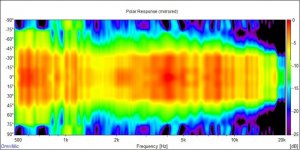 81425340_PolarMazLab.jpg.62dca93f1975032a84230f89a43b7879.jpg56.2 KB · Views: 576
81425340_PolarMazLab.jpg.62dca93f1975032a84230f89a43b7879.jpg56.2 KB · Views: 576 -
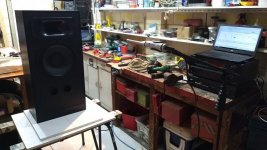 MazLab.jpg.2ad6afbdfd09e566dc1ad43721a43d84.jpg79.8 KB · Views: 543
MazLab.jpg.2ad6afbdfd09e566dc1ad43721a43d84.jpg79.8 KB · Views: 543 -
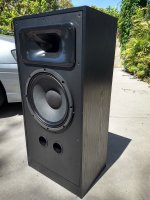 319022295_SEOS12CDX112PR300.jpg.bb14fb922ab8bbb4be518b955a74ac28.jpg226.5 KB · Views: 550
319022295_SEOS12CDX112PR300.jpg.bb14fb922ab8bbb4be518b955a74ac28.jpg226.5 KB · Views: 550 -
White Paper - Accurate In-Room Frequency Response to 10Hz.pdf749.9 KB · Views: 171
Last edited:
Pass DIY Addict
Joined 2000
Paid Member
I'll eventually get around to making some measurements with REW, but it's going to take a little while as I have a bunch of weekend travel coming up.
In the meantime, I have a few more images of the second speaker going together. I realized after I made these images that I forgot to add the small strip of hardwood under the tweeter horn that I put on the other speaker. Ooops...
These images are details of the tweeter installation, the bar grille to protect the woofer, the completed speaker, and a side-by-side of the FHXL and the Calpamos. The mounting lip of the horn and the woofer received some adhesive weather stripping before they were mounted to the cabinet.
From casual listening while spinning some CDs, the horns do what they are supposed to do - there is very little difference from sitting to standing and walking back and forth across the front of the speakers.
In the meantime, I have a few more images of the second speaker going together. I realized after I made these images that I forgot to add the small strip of hardwood under the tweeter horn that I put on the other speaker. Ooops...
These images are details of the tweeter installation, the bar grille to protect the woofer, the completed speaker, and a side-by-side of the FHXL and the Calpamos. The mounting lip of the horn and the woofer received some adhesive weather stripping before they were mounted to the cabinet.
From casual listening while spinning some CDs, the horns do what they are supposed to do - there is very little difference from sitting to standing and walking back and forth across the front of the speakers.
Attachments
Last edited:
I'll eventually get around to making some measurements...
Make sure to include some impedance curves, and also some nearfield measurements of the woofer. Both measurements are not very difficult to do, but are useful to check that everything works as intended.
Once you get into anechoic SPL curves, it would be VERY interesting to see some off axis measurements. It would be great if you could do horizontal off-axis measurements out to to 90" (or 180°) at 10° (or 5°) increments, as this would allow assessing how the Calpamos interact with the room, and how the in-room sound is.
- Home
- Loudspeakers
- Multi-Way
- My Calpamos Build
